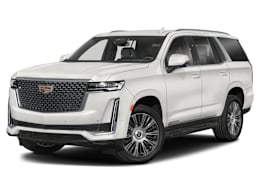Cadillac’s redesigned Escalade SUV doubles down on its identity as an imposing status symbol while making major improvements in ride quality, infotainment usability, and passenger comfort. But its fuel economy is dismal at 16 mpg overall, and handling remains clumsy.
Just like the Chevrolet Tahoe and Suburban SUVs that it’s based upon, the new Escalade benefits from an independent rear suspension that modernizes the driving experience. Aided by our test model’s optional adaptive dampers, the Escalade soaks up bumps remarkably well and the body stays steady and composed—overall, a much more fitting experience for a flagship vehicle than the previous model. Handling remains cumbersome, with noticeable body lean through corners, which isn’t surprising for such a large and heavy vehicle. But it still proved secure when pushed to its limits around our test track.
The standard 420-hp, 6.2-liter V8 engine delivers abundant and effortless power through a responsive and smooth-shifting 10-speed automatic transmission. However, our all-wheel-drive (rear-wheel drive comes standard) test vehicle only managed 16 mpg overall. A more fuel-efficient 277-hp, 3.0-liter six-cylinder diesel engine is also available, which garners an EPA-rated 22 mpg combined for the all-wheel-drive model.
The slick cabin overflows with high-tech features, including a triple-screen infotainment/instrument cluster setup that has vivid, easy-to-read graphics. An excellent four-zone climate control and a high quality sound system add to the first class ambience. Our test model’s optional soft-closing doors are another nice touch. Although the interior exudes luxury, with abundant leather and padded surfaces, it’s undermined by fake-looking wood trim and some rough edges here and there.
The wide front seats are comfortable and supportive, and include four-way lumbar adjustment for both the driver and passenger. The second-row captain’s chairs provide a roomy perch with ample headroom, good foot space underneath the front seats, and comfortable door- and inner pull-down armrests. The third-row seat has additional room over the previous Escalade thanks to the more space-efficient rear suspension setup. Although headroom is decent for a third-row, and an adult could survive back there in a pinch, the seat itself is small and flat and isn’t all that comfortable. The Escalade comes in two lengths, but even our “short” version packs a massive amount of cargo—56 cubic-feet by our measurement.
Like its Chevrolet siblings, the Escalade’s high step-in height compromises access, even when the optional air suspension drops the ride height some when parked. The tall hood hampers forward and front-side visibility, which can be troublesome in an urban setting with lots of pedestrians, such as at an intersection.
Forward collision warning and automatic emergency braking with pedestrian detection come standard, but blind spot warning and rear cross traffic warning don’t, a disappointment at this price. An enhanced version of Cadillac’s Super Cruise active driving assistance system—which assists the driver with acceleration, braking, and steering on pre-mapped divided highways—is available. There’s also an optional Night Vision system that helps identify pedestrians or animals beyond the range of the headlights.


























